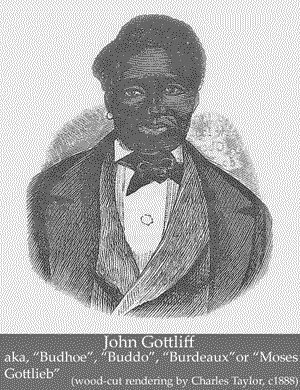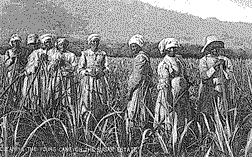John Gottliff: The Man Behind Buddoe
Slavery in the Danish West Indies ended abruptly on July 3, 1848, contrary to the intentions of the Danish Government and Governor General Peter von Scholten. It ended because several thousand enslaved individuals on St. Croix staged a largely non-violent demonstration that forced a reluctant Peter von Scholten to proclaim freedom for all of the “unfree” on St. John, St. Thomas and St. Croix. This, however, is not how the story has been told in most books and textbooks.
Only recently have we began to realize that Emancipation was a collective achievement of the enslaved, and that, moreover, it culminated decades of continuous, relatively peaceful, protest by many groups of heroic enslaved plantation laborers throughout the Danish West Indies. The story of emancipation as a popular movement began with the writings of the late Dr. Neville Hall in the 1980s. It has been continued by Dr. Svend Holsoe, who is preparing a major study of the Emancipation Rebellion from the bottom up. The path-breaking work of these scholars is based largely on testimonies of the enslaved participants recorded in the voluminous trial records compiled in the wake of the Emancipation. Their meticulous reconstructions of what took place in plantation villages and urban yards in advance of July 3, 1848 represent a necessary and important corrective to earlier histories. Thanks to this new research, men and women are emerging from the darkness of the past to take their rightful place in the historical record.
The large database of enslaved individuals on St. Croix being created by the St. Croix African Roots Project will also contribute to giving a voice and an identity to those who stepped forward in the name of Freedom. Its potential is indicated by the following biographical information about the one enslaved individual who until recently has been recognized as the only hero of 1848. I am referring, of course to John Gottliff, otherwise known variously as “Buddoe”, “Buddo”, “Bourdeaux”, or “Moses Gottlieb”.

John Gottliff was born enslaved on March 19, 1820 at Estate La Grange, a large sugar plantation located just outside of Frederiksted. His father’s identity has not been ascertained. His mother was Maria Rosina, who had been born enslaved on La Grange plantation in 1799.
Maria Rosina was listed as a field worker in 1818, and as a member of the big gang in the censuses of 1841 and 1846. Besides John Gottliff, she gave birth to two daughters: Mathilde Petrus, born in 1829, and Leah [aka Sanchy] Petrus, born in 1832. Their father was John Peter/Petrus born enslaved on Estate La Grange in 1801. In 1846, Maria Rosina married Anthony George, a rat catcher on Estate Little La Grange. In 1850, Anthony joined Maria Rosina on Estate La Grange, where the couple lived and worked until the 1860s, when they moved to Frederiksted. Anthony George died in Frederiksted in 1873. Maria Rosina George died of a sudden hemorrhage on a Frederiksted street in 1877.
Maria Rosina’s son, John Gottliff, appears in the censuses of 1841 and 1846 as belonging to the Lutheran Church and a member of the big gang. His character was described as “not too good” in 1841 and as “indifferent” in 1846. He was imprisoned for three months in 1840 for theft and for three months in 1841 for “insolence”. Obviously, he was not a submissive individual.
John Gottliff’s activities on July 3, 1848 and the days that followed have been chronicled by many writers. Dr. Svend E. Holsoe has provided the most reliable account, which is based on eyewitness testimonies extracted from official court records and other first-hand accounts. Holsoe shows that Gottliff was one of several figures that stood out among the crowd on July 3rd, but that he did not appear to be directing the action. After July 3rd, instead of joining those seeking revolution or retribution, Gottliff rode around the countryside urging protesters to lay down their weapons, cease looting and property destruction and return to work. Nonetheless, after calm had been restored, he was arrested and imprisoned by the Danes as a ringleader of the insurrection.
Gottliff’s role as an instigator of the rebellion is somewhat controversial. Throughout his intensive interrogations, he steadfastly maintained that he had nothing to do with organizing or leading the uprising. Holsoe has reached much the same conclusion and has identified Moses Robert of Estate Butler Bay and others as the principle organizers. But, several insurgents did identify John Gottliff as the chief organizer, and this role has been tentatively accepted by Dr. Neville Hall and, less critically, by other historians.

Whatever the truth of the matter, the Danish colonial officials decided, without a trial, to deport John Gottliff from the island in 1848. Documentary evidence has recently emerged that he was landed in Trinidad. He later made his way to New York City, where he appeared in the office of anti-slavery crusader Lewis Tappan in 1850. Thereafter, nothing further is known of him.
Among the many legacies John Gottliff left behind on St. Croix, was a daughter named Rebecca Bordeaux. Rebecca was born free on December 16, 1841. Her mother was Eliza/Elise/Ann Eliza Jackson, a free woman of color living in Frederiksted at the time of Rebecca’s birth.
Eliza Jackson was born circa 1821 on the island of St. John. In 1829, she came to St. Croix from St. John with her mother Mary Ann Gutliff. The background of Mary Ann Gutliff on St. John remains to be explored. Born enslaved, she may have lived on Estate Carolina in Coral Bay, for in the St. Croix Free Colored Census of 1831-32 it is recorded that William Beech, an attorney working for the Schimmelmann’s, (owners of both Estate Carolina and Estate La Grange), certified that she had been given free.
With her daughter Eliza and grand-daugther Rebecca, Mary Ann Gutliff moved from Frederiksted to Estate La Grange in 1852. They lived and worked there until early 1860, when they moved back to Frederiksted. Mary Ann Gutliff died in Frederiksted of old age in 1877. Her daughter, Eliza Jackson died of natural causes in the Frederiksted hospital.
The fate of Rebecca Bourdeaux, like that of her father, remains unclear. No one with that name could be located in the census, church or death records of St. Croix after 1860. In the 1880 census, a Rebecca “Gutlieb”, born in 1841, appears as owning and living at Friedensthal No. 12, on the outskirts of Christiansted. But, Gutlieb was her married name, which she took from her husband Frederik Gutlieb, 32 years of age. This Rebecca appears as widow “Gutloff” in the 1901 census. She died in Christiansted in 1905. As far as can be determined she left no descendants. Was she Buddoe’s daughter? Or did Rebecca Bordeaux leave St. Croix forever in the 1860s, perhaps to join her father in the United States? Hopefully, the answer will one day be revealed as we dig ever deeper into the marvelously rich archives compiled about our ancestors by the Danes.
[Emancipation]
